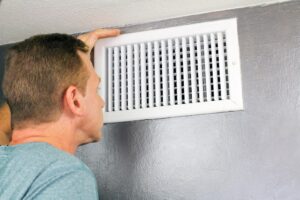If you’ve ever heard people refer to the “shoulder months,” you may wonder what this phrase means and how it relates to the overall comfort in your Bath, Pennsylvania, home. (HVAC)Shoulder months are the times of year when the temperatures can vary between about 40 and 70 degrees Fahrenheit. The months often fall during the spring and fall, when the temperatures can fluctuate drastically from the start to the end of the day. Maintaining home comfort during the shoulder months can be challenging, but you can save energy while you do it.
Use the Programmable Thermostat
The first step in handling the (HVAC) shoulder months is allowing your programmable thermostat to do its job. If you’re in the habit of making manual adjustments to the temperature, now is the time to break this energy-wasting habit. When you set a comfortable temperature on your thermostat, you should try to leave it alone to allow the system to run at peak efficiency while maintaining the comfortable atmosphere you want. As the seasons change, set a few minutes aside to reprogram the thermostat for the new weather conditions.
If you want to maximize comfort and energy savings, consider upgrading to a smart thermostat. These Wi-Fi-enabled devices can track your habits and make automatic adjustments to reduce energy waste without altering the comfort level in your home. Some smart thermostats also have outdoor temperature sensors and can make adjustments as the weather changes outside, which can really help you beat the challenges that come during the shoulder months.
Figure Out the Comfortable Setting for Your Home
Another important aspect of handling the changing seasons is figuring out the ideal temperature for your home. Your ideal temperature probably isn’t the same as everyone else within the house. However, you can play around with the settings and find a temperature upon which everyone can agree, ending the thermostat wars. For most people, ideal thermostat settings in the cooler months are between 65 and 68 degrees Fahrenheit, while the summer months feel more comfortable with settings between 75 and 80 degrees Fahrenheit.
As you determine the optimal temperature level, consider that people tend to sleep better when the temperature is lower. Allowing your house to cool off around bedtime and throughout the night will also help reduce your monthly energy bills and lessen the amount of waste. Try adjusting the temperature by 1 degree Fahrenheit at a time. Most people won’t notice a substantial difference in the overall comfort level, but it can help you save up to 1 percent of your total bill.
Rely on Spring and Fall Breezes
When the temperature is more pleasant outside, take advantage by allowing cool breezes to come into your home. Open the windows to ensure that cool air can flow through the space, helping to cool it down without costing you a dime. If your windows don’t have screens, it’s smart to install screens before you open them, as wide-open windows tend to let bugs and other pests into your home. Pleasant temperatures are major benefits that come with the unpredictable shoulder months. Therefore, take advantage and allow some fresh air into your home.
Maintain the Indoor Air Quality
During the spring and fall seasons, many people allow the outdoor air to come in, which can help cool down your space and help you save energy. However, if anyone in the house suffers from allergies, he or she may start to experience worsening symptoms when the contaminants from outside are allowed indoors. During the shoulder months, be vigilant about maintaining the indoor air quality.
You can schedule a duct cleaning service to get rid of contaminants that might have settled within the ducts, which will improve the quality of the air you breathe. This service will also help your HVAC system to run more efficiently, which will be helpful as the weather shifts again and you rely more heavily on your heating or cooling system.
If you’re having trouble managing temperature swings during the (HVAV) shoulder months, contact us for HVAC service at Sullivan Oil & Propane at (610) 810-3992.
Image provided by Shutterstock



